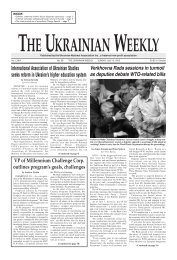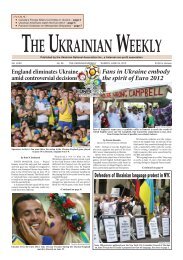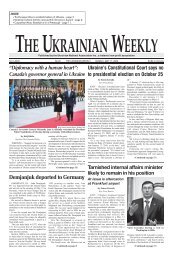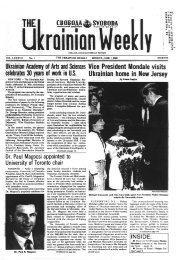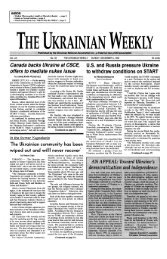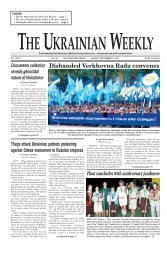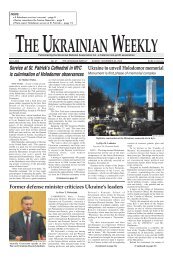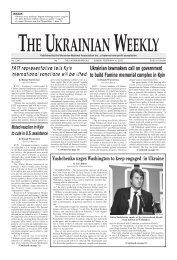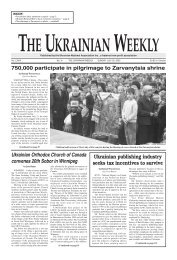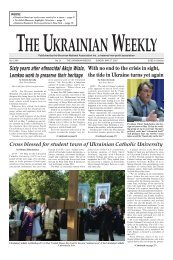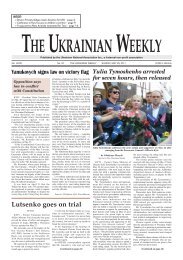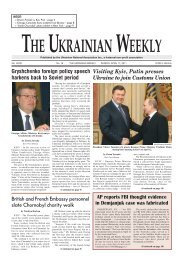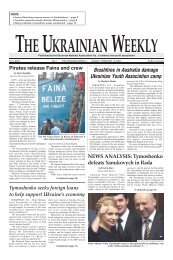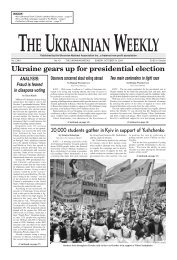1_January 6, 2002 - The Ukrainian Weekly
1_January 6, 2002 - The Ukrainian Weekly
1_January 6, 2002 - The Ukrainian Weekly
You also want an ePaper? Increase the reach of your titles
YUMPU automatically turns print PDFs into web optimized ePapers that Google loves.
18 THE UKRAINIAN WEEKLY SUNDAY, JANUARY 6, <strong>2002</strong><br />
No. 1<br />
2001: THE YEAR IN REVIEW<br />
<strong>Ukrainian</strong> Churches:<br />
papal visit tops the news<br />
Religious activity in Ukraine came to a historic<br />
peak this year when the country’s Greek-<br />
Catholic faithful, long persecuted under Soviet<br />
rule, welcomed the head of the Catholic Church and the<br />
successor to St. Peter on ancient Rus’ soil. <strong>The</strong> holy<br />
father’s pilgrimage, which roused strong opposition<br />
from some Orthodox cirlces, fulfilled a long-held dream<br />
of both the <strong>Ukrainian</strong> faithful and the Catholic primate<br />
to openly and jointly concelebrate eastern rite liturgy.<br />
For five days between June 23 and 27, Pope John<br />
Paul II, the leader of nearly 1 billion faithful of the<br />
Catholic Church, visited his 6-million-strong flock in<br />
Ukraine in a trip that, in the end, surpassed all expectations.<br />
It left an indelible mark on the millions who came<br />
out to see him, as well as on his relations with the<br />
<strong>Ukrainian</strong> Greek-Catholic Church that has been in communion<br />
with the Vatican See for over 400 years.<br />
It was the 94th official foreign journey in the 24<br />
years of the papacy of the Polish holy father, but one<br />
that his personal secretary called “a long-held dream,”<br />
one that he had talked about for “11, 12, even 14 years.”<br />
Nearly 3 million people, the faithful and the curious,<br />
saw the aging and frail pontiff during a youth rally and<br />
at four divine liturgies, two in Kyiv and two in Lviv –<br />
celebrated in the Latin and Byzantine rites. People came<br />
from all over the world: <strong>Ukrainian</strong>s from Australia,<br />
Canada and the United States, along with hundreds of<br />
thousands of Poles and thousands of Belarusians and<br />
Russians, Germans, Hungarians, Romanians, Czechs,<br />
Slovaks, and two Congolese who happened to have<br />
been in Kyiv at the time.<br />
In many ways it was a trip home. Although Pope<br />
John Paul II was not born in Ukraine, his <strong>Ukrainian</strong><br />
mother was born outside of Drohobych. And while this<br />
was his first trip to Ukraine as the head of the Catholic<br />
Church, he had spent time in the western part of the<br />
country in his youth and had been stationed there during<br />
his military service.<br />
Attendance was low at the two divine liturgies<br />
offered during Pope John Paul II’s stay in Kyiv because,<br />
not only was the weather threatening, but people were<br />
put off by the tight security and a belief that more of the<br />
same would make it difficult to get to the Chaika<br />
Aerodrome. <strong>The</strong> distance to the aerodrome, located<br />
eight miles from the city center, also did not help.<br />
<strong>The</strong>re were bright spots, however – first and foremost<br />
at the meeting of the <strong>Ukrainian</strong> Council of Churches<br />
and Religious Organizations, where the holy father was<br />
quite unexpectedly greeted with hugs and kisses by the<br />
leaders of two of three Orthodox confessions in<br />
Ukraine. Warm words by the chief rabbi of Kyiv and<br />
Ukraine and the head mufti of the Crimean Tatars gave<br />
further proof that it was only a minority of Ukraine’s<br />
confessions that opposed the pope’s journey to Ukraine.<br />
<strong>The</strong> papal visit caused a large wave of concern<br />
among certain Orthodox leaders. Metropolitan<br />
Volodymyr (Sabodan) of the <strong>Ukrainian</strong> Orthodox<br />
Church – Moscow Patriarchate (UOC-MP) requested<br />
that Pope John Paul II’s trip to Ukraine be postponed in<br />
a written letter approved by the UOC-MP Holy Synod<br />
and Council of Bishops issued on <strong>January</strong> 22.<br />
Metropolitan Volodymyr said the current poor relations<br />
between <strong>Ukrainian</strong> Greek-Catholics and <strong>Ukrainian</strong><br />
Orthodox faithful in western Ukraine was the main reason<br />
he opposed the scheduled visit.<br />
<strong>The</strong> letter threatened that, if the pope’s visit went<br />
ahead as planned, Metropolitan Volodymyr and the 42<br />
hierarchs of the UOC-MP, which are part of the Russian<br />
Orthodox Church and continue to claim millions of<br />
faithful in Ukraine, would not meet the holy father, and<br />
none of their clergy would take part in the program of<br />
the visit. <strong>The</strong> letter seemed to be an attempt to forbid<br />
the pope to meet with anybody representing either of<br />
the two <strong>Ukrainian</strong> Orthodox churches that do not recognize<br />
the Moscow Patriarch – and particularly named<br />
Patriarch Filaret of the <strong>Ukrainian</strong> Orthodox Church –<br />
Kyiv Patriarchate, whom the Moscow Patriarchate had<br />
excommunicated.<br />
<strong>The</strong> letter requesting that the pope should have “postponed”<br />
his visit to Ukraine seemed an unsuccessful<br />
attempt to disguise a deeper motive: the UOC-MP was<br />
notifying the pope that it does not want him in Ukraine<br />
at all, ever.<br />
Reacting to these efforts by the UOC-MP to have the<br />
visit canceled, both the <strong>Ukrainian</strong> government and the<br />
Vatican issued strong statements on <strong>January</strong> 23 stating<br />
Pope John Paul II and President Leonid Kuchma are surrounded by <strong>Ukrainian</strong> children in national costumes<br />
upon the pontiff's arrival at Boryspil airport on June 23.<br />
that such actions will not derail the pontiff’s June trip. A<br />
Vatican spokesman that same day issued a statement<br />
reconfirming the pope’s plans. <strong>The</strong> statement explained<br />
that the 86-year-old pontiff “will meet with <strong>Ukrainian</strong><br />
Catholics, and he hopes that he will be able to promote<br />
a peaceful ecumenical dialogue in this country.” It<br />
added, “<strong>The</strong> visit is to take place as it was scheduled.”<br />
In protest against the papal visit some 250 faithful of<br />
the UOC-MP marched from the Monastery of the Caves<br />
in Kyiv, one of the holiest sites of Orthodoxy, to the<br />
Verkhovna Rada building on May 25, calling for the<br />
visit to be canceled.<br />
<strong>The</strong> head of the UOC-MP also expressed concern<br />
that the pontiff would meet with the leaders of the two<br />
other <strong>Ukrainian</strong> Orthodox confessions, the UOC – Kyiv<br />
Patriarchate and the <strong>Ukrainian</strong> Autocephalous Orthodox<br />
Church, both of which the Moscow Church views as<br />
non-canonical.<br />
On June 21, about 3,000 UOC-MP supporters again<br />
protested on the streets of Kyiv carrying placards proclaiming,<br />
“<strong>The</strong> pope is persona non-grata,” “<strong>The</strong> pope<br />
is the forerunner of the anti-Christ” and “Orthodoxy or<br />
death.” It was the fourth and largest protest by UOC-<br />
MP faithful preceding the holy father’s visit.<br />
During a press conference in Kyiv on May 29, the<br />
papal nuncio to Ukraine, Archbishop Nikola Eterovic,<br />
delineated a threefold mission for the pope’s trip: to<br />
meet with the leadership of the <strong>Ukrainian</strong> Catholic<br />
Church, which “has deep roots and is very dynamic,” as<br />
the archbishop explained, and celebrate its successful<br />
revival after persecution under Soviet rule; to develop<br />
contacts with the <strong>Ukrainian</strong> government; and to continue<br />
a dialogue with the Orthodox Church in Ukraine.<br />
Pope John Paul II won over many Kyivans with<br />
assertions that he recognizes the ancient city as the “cradle<br />
of Eastern Christianity,” a statement he used during<br />
several appearances and one repeated by his press secretary<br />
during a meeting with journalists.<br />
He also gave <strong>Ukrainian</strong> Greek-Catholics great pleasure<br />
by stopping at St. Nicholas Church, their tiny sanctuary<br />
located at the site of the Askold’s Tomb shrine in<br />
Kyiv. <strong>The</strong>re the pontiff prayed to the Our Lady of<br />
Zarvanytsia, whose icon had been brought to Kyiv from<br />
the tiny village in western Ukraine especially at the<br />
pope’s request.<br />
During his two and a half days in Kyiv, Pope John<br />
Paul II made quick and quiet side trips to honor those<br />
murdered by the two totalitarian regimes that scourged<br />
Ukraine through much of the 20th century.<br />
On June 24 in the woods outside Bykivnia, a small<br />
village bordering Kyiv, the pope memorialized and paid<br />
tribute to the thousands of <strong>Ukrainian</strong> religious and political<br />
leaders, artists, writers and teachers who were executed<br />
there during Stalin’s Great Terror.<br />
On June 25 he paid his respects to the 32,000 Jews<br />
massacred by the Nazis at Babyn Yar in a 72-hour time<br />
period and to the tens of thousands of Jews and Kyiv<br />
residents of other nationalities also murdered there.<br />
<strong>The</strong> pope also visited St. Alexander’s Roman<br />
Catholic Church on the last day of his Kyiv trip and met<br />
AP/Efrem Lukatsky<br />
with political and business leaders at Mariinsky Palace.<br />
Sixteen of the 17 leaders of the largest religious confessions<br />
met with the head of the Catholic Church on June<br />
24 at Kyiv Symphony Hall. Not present was<br />
Metropolitan Volodymyr Sabodan of the UOC-MP,<br />
which had said from the outset that its leader would not<br />
meet with the pope.<br />
However, the most interesting moment occurred at<br />
the very beginning of the hour-long meeting, when during<br />
introductions the leaders of the other two Orthodox<br />
confessions, Patriarch Filaret of the <strong>Ukrainian</strong> Orthodox<br />
Church – Kyiv Patriarchate and Metropolitan Mefodii<br />
of the <strong>Ukrainian</strong> Autocephalous Orthodox Church<br />
kissed the holy pontiff on both cheeks. At the end of the<br />
meeting they repeated their actions, clearly in defiant<br />
response to threats from ROC Patriarch Aleksei II that<br />
any private discussions between what his Church considers<br />
illegal, non-canonical elements of <strong>Ukrainian</strong><br />
Orthodoxy and the pope could lead to a breakdown in<br />
relations between Moscow and the Vatican.<br />
<strong>The</strong> rhythm of the visit markedly quickened and took<br />
on a soaring element when the pope’s <strong>Ukrainian</strong> airliner<br />
touched down in Lviv. <strong>The</strong>re the mood of Pope John<br />
Paul II, who had acted soberly and with restraint during<br />
the first part of his trip, lightened considerably.<br />
He was greeted by hundreds of thousands of enthusiastic<br />
supporters and well-wishers as his entourage and<br />
his popemobile wound through the narrow, cobblestone<br />
streets of the medieval town. It gathered more momentum<br />
during the first mass, celebrated in Polish in the<br />
Latin Rite and largely attended by Poles from across the<br />
– more than 100,000 of whom had crossed the border<br />
on the previous day.<br />
<strong>The</strong> trip began to crescendo that afternoon at a youth<br />
rally attended by a crowd estimated at 250,000 to<br />
500,000 mostly young people. As what seemed like a<br />
never-ending downpour continued to drench and chill<br />
the crowd, Pope John Paul II interrupted his homily and<br />
spontaneously broke into song. For more than a minute,<br />
with an unusually sure and steady voice, he sang several<br />
stanzas of a Polish folk song calling for the rain to stop.<br />
<strong>The</strong> solo caused squeals of delight and laughter, and<br />
raised the spirits of the drenched multitudes.<br />
<strong>The</strong> climax, however, occurred the next day, when<br />
between 1 million and 1.5 million people descended on<br />
the Lviv Hippodrome for the <strong>Ukrainian</strong> Greek-Catholic<br />
liturgy and the beatification of 27 martyrs of the faith<br />
and the foundress of a religious order, the largest single<br />
group to achieve the status of “blessed” in the more<br />
than 400-year history of the UGCC.<br />
Jeffrey Wills, spokesperson for the UGCC press service,<br />
called it “the largest gathering of people in history<br />
for a Byzantine liturgy.” Father Borys Gudziak, rector<br />
of the Lviv <strong>The</strong>ological Institute, referring to the<br />
Byzantine tradition in which everybody takes part in<br />
singing the liturgy, called it the “largest choir ever<br />
assembled.”<br />
<strong>The</strong> 28 blessed – 26 of whom perished as a result of<br />
Soviet persecution between 1935 and 1973, and one<br />
who died at the hands of the Nazis at the Polish concen-



